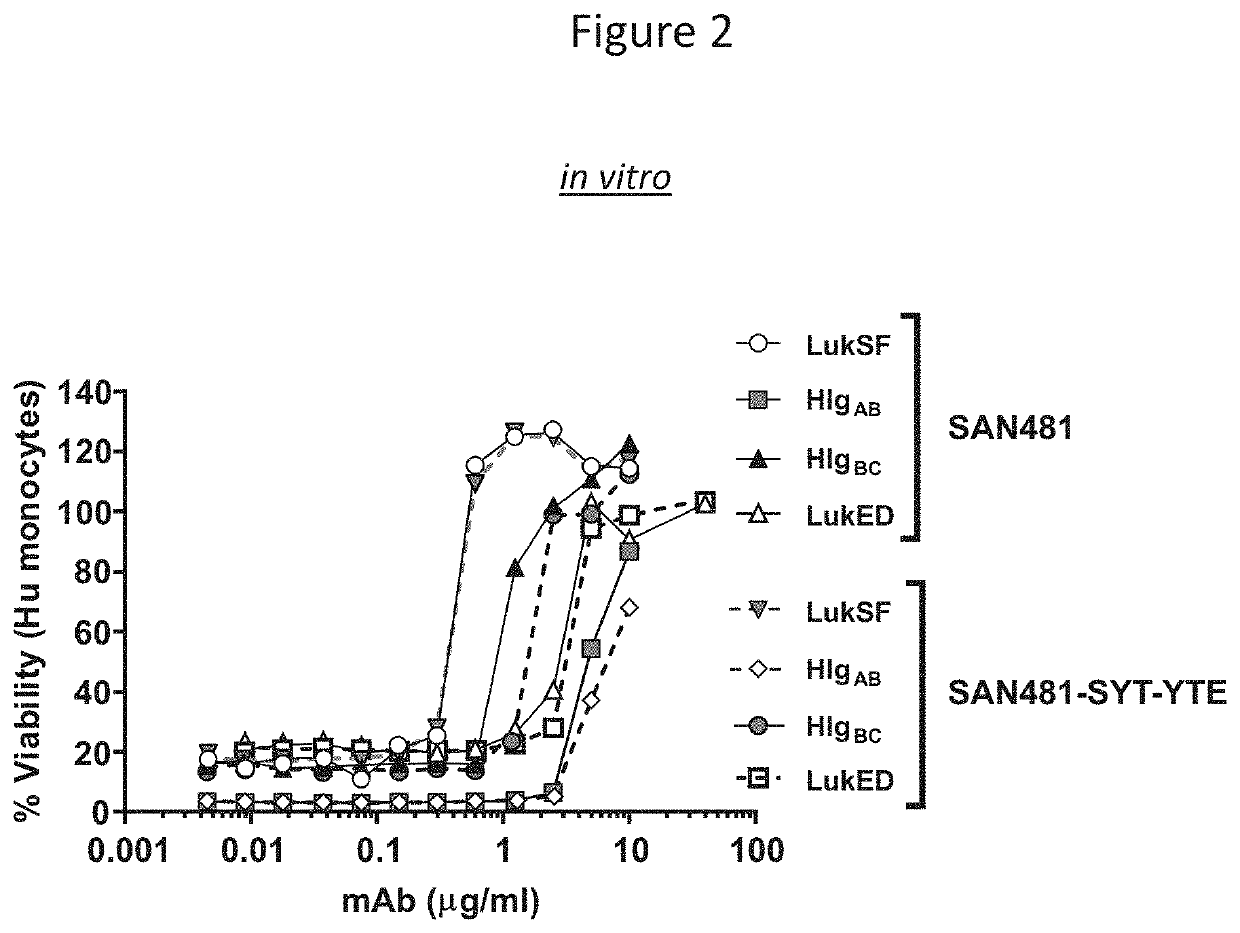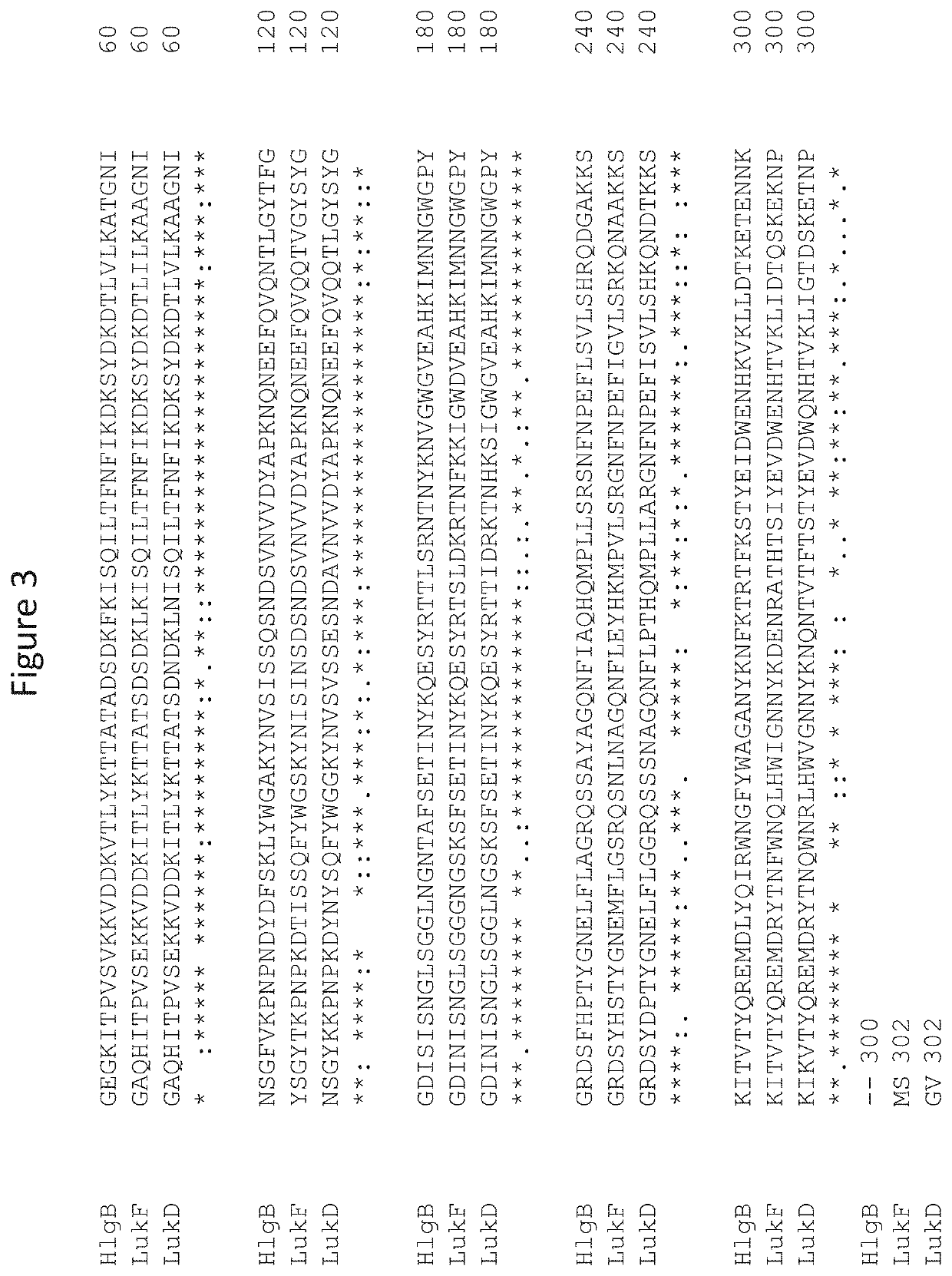Antibodies directed against staphylococcus aureus leukotoxins
- Summary
- Abstract
- Description
- Claims
- Application Information
AI Technical Summary
Benefits of technology
Problems solved by technology
Method used
Image
Examples
example 1
[0102]The anti-leukotoxin antibody SAN481 comprises a heavy chain with the amino acid sequence of SEQ ID NO:9 and a light chain with the amino acid sequence of SEQ ID NO:10. Several sequence liabilities were identified in these sequences. For example, oxidation of heavy chain W100a (inVH-CDR3) and M256 (in the Fc domain) were observed. In addition, a glycosylation site (NFS) in the variable heavy chain was 70% glycosylated. Two NS deamidation sites were identified in VL-CDR1, and a DG / DS isomerization site was identified in VH-CDR2. Furthermore, light sensitivity resulted in a 3.5% increase in aggregation of SAN481 upon 1 wk CWL-2kLux.
[0103]In order to achieve an improved SAN481 antibody variant, a series of sequence variants were designed and tested. The variants were designed to remove these liabilities and to increase half-life without impacting the leukotoxin neutralization activity of the antibody. (Initial attempts to remove sequence liabilities resulted in the loss of binding...
example 2
[0106]This example demonstrates that, unlike other SAN481-variants, the SAN481-SYT-YTE antibody maintains the in vitro activity of SAN481.
[0107]In vitro assays were conducted in order to evaluate the activity of SAN481 variants. In these assays, differentiated HL60 human monocytic cells (2.5e4 well / 25 μl) were incubated for 2 hours at 37° C. with 50 μl of a mixture of LukSF (100 ng / ml each) or HIgAB (400 ng / ml each) and serial dilutions of each mAb mutant (25 μl) as indicated on FIG. 1. The percentage of cell viability was measured using a Cell Glo assay and calculated as follows: 100*[(OD450 cells+toxin+mAb) / (OD450 cells alone)]. The concentration of mAb required to achieve 50% inhibition of viability (IC50) was calculated, and reported on Table 9.
TABLE 9LukSF and HIgAB Activity of SAN481 VariantsIC50IC50IC50IC50for LukSFFold lossfor HIgABFold lossVariant(μg / ml)vs. WT(μg / ml)vs. WTSAN481-YTE0.14990.93750.53990.9497(QD1)SAN481-SY-YTE0.18261.14200.55130.9697(QD2)SAN481-T-YTE0.16561.03...
example 3
[0109]This example demonstrates that the SAN481-SYT-YTE antibody has similar in vitro leukotoxin neutralization as the SAN481 antibody.
[0110]The in vitro leukotoxin neutralization activity was tested by an assay measuring cell viability. More specifically, differentiated HL60 human monocytic cells (2.5e4 well / 25 μl) were incubated for 2 hours at 37° C. with 50 μl of a mixture of LukSF (100 ng / ml each), LukED (2000 ng / ml each), HlgCB (200 ng / ml each) or HIgAB (400 ng / ml each) and serial dilutions of SAN481 or SAN481 SYT-YTE (25 μl) as indicated on FIG. 2. The percentage of cell viability was measured using a Cell Glo assay and calculated as follows: 100*[(OD450 cells+toxin+mAb) / (OD450 cells alone)], and graphed on FIG. 2.
[0111]The results, shown in FIG. 2, demonstrate that SAN481-SYT-YTE and SAN481 have similar in vitro neutralization activity against all of LukSF, HlgAB, HlgBC, and LukED.
PUM
| Property | Measurement | Unit |
|---|---|---|
| Molar density | aaaaa | aaaaa |
| Electrical conductance | aaaaa | aaaaa |
| Fraction | aaaaa | aaaaa |
Abstract
Description
Claims
Application Information
 Login to View More
Login to View More - R&D
- Intellectual Property
- Life Sciences
- Materials
- Tech Scout
- Unparalleled Data Quality
- Higher Quality Content
- 60% Fewer Hallucinations
Browse by: Latest US Patents, China's latest patents, Technical Efficacy Thesaurus, Application Domain, Technology Topic, Popular Technical Reports.
© 2025 PatSnap. All rights reserved.Legal|Privacy policy|Modern Slavery Act Transparency Statement|Sitemap|About US| Contact US: help@patsnap.com



